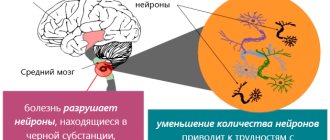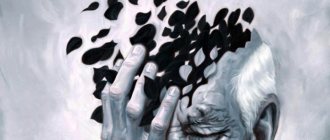Frontotemporal dementia is a neurodegenerative disease accompanied by progressive behavioral and personality disorders. Over time, especially without properly selected treatment, a person completely loses the ability to have full productive contact with others (total dementia). The pathology develops against the background of degenerative changes in the frontal and anterior temporal lobes of the brain. To date, there are no treatment protocols or medications that can be used to cure a person suffering from frontotemporal dementia (FTD), however, doctors at the Leto Mental Health Center will individually select drug therapy that can slow down the progression of severe symptoms.
Classification
In accordance with modern standards of psychotherapy, several forms of frontal dementia are distinguished:
- behavioral with a predominance of personality disorders (occurs most often);
- agrammatic (semantic);
- logopenic (however, according to some experts, this option is rather one of the atypical varieties of Alzheimer's disease).
Atrophy may affect the temporal, frontal, or frontotemporal regions of the brain. The location of the focus is another criterion for determining the form of the disease.
Clinical picture
The disease begins between 45 and 70 years , there are no cases of frontotemporal dementia in adolescents (if similar symptoms are present in younger people, a more thorough diagnosis is required, since either hereditary mental illnesses or disorders due to organic brain damage are likely). Symptoms develop gradually.
In the early stages, personality changes predominate, the severity of which depends on the exact localization of the neurodegenerative process. With dementia of the frontal type, the following gradually develop:
- inactivity;
- lethargy;
- absence of external emotional manifestations;
- indifference to everything that happens around;
- reduction and simplification of mental activity,
- slowing, distortion of speech (up to loss of the ability to speak),
- lack of movement, recumbent lifestyle.
When the pathological process is localized in the orbital cortex, the following prevail in the clinical picture:
- loss of sense of tact and distance;
- loss of moral attitudes and principles;
- impulsiveness of actions;
- gross impairments of the cognitive spectrum (the ability to abstract thinking, planning, and performing multi-stage actions is lost), but at the same time memory and orientation in space and the environment are preserved.
Atrophy of the temporal lobes is accompanied by stereotypies - meaningless, illogical repetitions of phrases or individual words, movements, for example, stomping, clapping, rubbing the skin, scratching, pursing lips, smacking, etc. Sometimes obsessive counting appears: the patient constantly counts the number of steps, steps, etc. passed.
In addition, there is a clearly pathological tendency towards cleanliness, which sometimes takes the form of a phobia. Another form of stereotypy is the strictest adherence to an established daily routine, the change of which causes real panic in a person.
In addition, FTD is accompanied by:
- asthenic symptoms (weakness, fatigue, headaches, insomnia);
- movement disorders, muscle rigidity;
- formation of delusional ideas;
- speech disorders (and in 60% of patients they are noted at the initial stage of pathology).
One of the key symptoms is the early loss of the ability to understand and empathize with others' emotions. A person ceases to be interested in the feelings and experiences of those around him (including close people), he is indifferent to the grief of others, which is why the patient usually ends up in social isolation.
Changes in eating behavior are also characteristic. Frontotemporal dementia is typically characterized by an addiction to sweets, or to foods of a strictly specific color, shape, or with a specific smell. The feeling of satiety is lost. In later stages of FTD, the patient may strive to taste any objects, including those that are clearly inedible.
Frontotemporal degeneration (FTD) is a common cause of presenile dementia, accounting for 5 to 17% of autopsy-confirmed cases developing before the age of 70 years [1]. It manifests itself with a wide range of clinical symptoms: from behavioral disorders to speech and motor disorders.
We present a clinical observation.
Patient M.
, 71 years old, retired. Upon admission to the neurological hospital, he did not present any complaints on his own due to severe speech disorders. Referred by a neurologist at the clinic to undergo a planned course of treatment for the “consequences of a stroke.”
Anamnesis from the words of his wife.
In 2002, the patient was diagnosed with rectal cancer and underwent colostomy surgery.
Around the same time, he stopped going out, which his relatives attributed to the consequences of the operation. At home he did household chores. At the same time, relatives began to notice that M.
could not always correctly say the name of a loved one and confused the sequence of events occurring during the day.
These disorders developed gradually and did not interfere with the patient’s ability to perform household duties. In 2009, an episode occurred during which the patient, being at home alone, cooked borscht and after a while asked his wife who cooked it. The wife called an ambulance, the patient was transported to a neurological hospital, where a diagnosis of stroke was made, but the patient refused hospitalization. Later, relatives began to notice that M.
was forgetting some words and the names of objects, especially those rarely used.
In 2011, a neurologist prescribed the drug reminil at a daily dose of 16 mg. Over the next 2 years, the speech impairment progressed; gradually the patient no longer understood speech addressed to him, but could easily perform the desired action after seeing an object. Communication with M.
took place through written instructions and gestures.
His own speech became increasingly impoverished, and he retained the ability to only give monosyllabic answers and use obscene language. At the same time, relatives began to notice changes in M.'s
: he began to hide money, keys, and was constantly looking for something in closets and drawers.
At the same time, he continued to play cards and checkers, and no one at home could beat him. Sleep was disturbed, the patient began to wake up frequently, waking up his wife. In recent months, he began to constantly express a desire to smoke, in connection with which electronic cigarettes were provided. Until now, he is able to perform household duties, for example, he can peel potatoes well if he is shown the necessary action, washes dishes, and cleans. According to his wife, the patient was always pedantic in relation to personal hygiene and order in the house, he always carefully made the bed, kept his clothes clean, and was careful when eating. At the same time, M.
became reluctant to wash himself and stopped brushing his teeth. If earlier he did not start eating until his wife sat down at the table, now he does not always wait for her. He forgets that he took food; if you bring him breakfast a second time, he will eat it. He can spread butter on bread himself and does it extremely carefully. He began to show with gestures that he was not averse to drinking alcohol. If a patient is given a pack of cigarettes, he will smoke it all without a break.
Anamnesis of life.
Secondary education, retrained left-hander. From the age of 18 he worked as a metal melter in a hot shop, and from the age of 50 he retired. There were no cases of dementia in the family; the parents died during the Great Patriotic War. The sisters suffered from type 2 diabetes mellitus (DM), insulin-dependent. One of the sisters, aged 67 years, had speech disturbances that were interpreted as a stroke. The son and daughter suffer from hypertension. The patient has been suffering from type 2 diabetes for 3 years and receives insulin. From the age of 15 I smoked Prima cigarettes two packs a day. At times he abused alcohol.
Upon examination, the general condition is satisfactory. Blood pressure 130/80 mm Hg. Pulse - 74 per minute, rhythmic.
Neurological status.
Conscious. Contact is difficult due to speech impairments. There are no meningeal signs. Cranial nerves are intact. Strength in the limbs is preserved, muscle tone is not changed. Tendon reflexes are alive, equal, and there are no pathological signs. Sensitivity cannot be reliably assessed. The coordination sphere is not broken. No extrapyramidal signs were identified. The gait is not changed. Controls the functions of the pelvic organs.
Neuropsychological research.
Own speech is presented in the form of constant pronunciation of individual sounds and syllables, the intonation component is partially preserved. He does not understand speech addressed to him. Able to read written text with significant phonetic distortions. Doesn't execute written commands. There is no spontaneous writing. Can complete in writing an arithmetic problem initiated by the examiner. Copies the written word correctly. Can repeat gestures, including quite complex ones, but confuses the right and left sides. Easily copies complex geometric shapes. Places numbers on the dial drawn by the researcher, does not show any attempts to determine the time. To perform any test, the examiner must begin doing it with the patient. He performs the “fist-rib-palm” test correctly together with the examiner, but does not continue the action independently. He is easily distracted, but completes all tasks to the end. Perseverations are noted. Observation of the patient (crossing his arms over his chest, interlocking his fingers, kneeling) suggests the presence of hidden left-handedness.
Survey results
. In a biochemical blood test, the fasting glucose level increased to 8.6 mmol/l. A study was carried out on the content of total protein and albumin, as well as vitamin B12 and folic acid in the blood serum; no deviations from the norm were detected.
According to MRI of the brain, a decrease in the brain parenchyma of the right and left temporal, left frontal, parietal and occipital lobes with deepening and expansion of convexital spaces and intergyral spaces is determined as a manifestation of atrophy of the brain substance (Fig. 1).
Rice. 1. MRI images of the brain. a, b — T2-axial projections; c — T1-sagittal projection; d — T2-coronal projection. There is a significant uneven expansion of the convexital and intergyral spaces due to cortical atrophy, most pronounced in the left temporal and frontal lobes (arrows).
When conducting diffusion tensor imaging of the pathways of the white matter of the brain, a decrease in the representation of the tracts is determined, as well as a violation of their sequential linear orientation in the form of a partial interruption in the area of the corpus callosum (Fig. 2).
Rice. 2. Diffusion tensor MR tractography (DTI). A decrease in the representation of tracts is determined, as well as a violation of their sequential linear orientation in the form of a partial interruption in the region of the trunk of the corpus callosum (arrows).
In terms of differential diagnosis of the identified disorders, it seems appropriate to distinguish FTD from dementia of deficiency origin. In particular, given a history of rectal cancer and rectal resection, it is possible to consider vitamin B12 and folic acid deficiency as a cause of cognitive deficit. It is believed that dementia caused by vitamin B12 deficiency does not have pathognomonic clinical manifestations [2, 3]. The patient also does not have typical signs of funicular myelosis. The identified neuroimaging changes differ from those observed in B12-deficiency dementia (mild cerebral atrophy of predominantly the frontal and parietal lobes of the brain). In addition, normal levels of vitamin B12 and folic acid in the blood serum can exclude this nature of dementia. Another potential cause of the development of cognitive impairment is a lack of nicotinic acid against the background of carcinoid syndrome [4], which is also found in tumors of the colorectal region; the patient can also be excluded due to the absence of typical skin manifestations, diarrhea and anorexia.
It would be interesting to discuss the potential relationship between FTD and SD. Theories have been put forward to explain the unity of the pathogenesis of neurodegenerative and other age-dependent diseases, in particular type 2 diabetes - the role of mRNA-binding proteins [5] and the Vps10 family of proteins and the retromer complex [6]. Finally, there is increasing evidence of a relationship between insulin activity and tau protein hyperphosphorylation [7].
It is relevant to divide FTD into behavioral variant and primary progressive aphasia (PPA), which includes three variants: semantic, logopenic and nonfluent [8]. It is impossible to definitively determine the type of FTD in a patient solely on the basis of the clinical picture due to the severity of aphasic disorders, which do not allow a detailed analysis of the speech sphere. On the other hand, biomarkers identifying FTD have not yet been developed, so neuroimaging is of great importance. It has been shown that the semantic variant of PPA (semantic dementia), associated with DNA-binding protein (TDP) type 2 pathology [9], is manifested by atrophy of the left anterior medial temporal cortex [10]; involvement of the right temporal lobe is also typical [11]. The logopenic variant of PPA (mixed aphasia) is characterized by atrophy of the left posterior temporo-parietal region [12]. The nonfluent variant of PPA associated with tauopathy is characterized by atrophy of the left inferior frontal insula and anterosuperior parts of the temporal lobe [8].
A recent study [13] showed the presence of changes in the white matter of the brain: predominantly damage to the uncinate, cingulate fascicles and corpus callosum in the behavioral variant of FTD. According to the authors, in the pathogenesis of the disease it is important that the changes in the fibers corresponded locally to the zones of gray matter atrophy, but were distributed more widely. Our study also revealed a violation of the integrity of the tracts in the region of the trunk of the corpus callosum.
The influence of the patient’s latent left-handedness on the clinical manifestations of dementia is also important. We did not find any studies that directly discussed this phenomenon in FTD. At the same time, in relation to patients with focal brain damage, it has been shown that speech disorders in retrained left-handers differ from those in right-handers in the atypicality and fragmentation of speech disorders [14]. This may be explained by the fact that in conditions of damage to the speech-dominant left hemisphere, the subdominant right hemisphere often becomes especially active functionally, and this most often occurs in patients with signs of left-handedness, i.e., persons with an individually determined non-standard coefficient of hemispheric asymmetry. The speech of such patients is characterized by fluency and the predominance of stylistically individually colored speech cliches, established in premorbid speech practice [15]. The peculiar dynamics of the development of speech disorders, the preservation of the intonation component of speech, the alienation of the meaning of words, the partially preserved ability to read and intact counting in the patient can be explained both by this phenomenon and by the peculiarities of the spread of the neurodegenerative process, involving both hemispheres of the brain and affecting the tertiary fields of the temporal lobe .
Thus, this clinical case seems interesting from several points of view: 1) an almost isolated speech disorder in a patient in the presence of cardiovascular risk factors led to an erroneous diagnosis of acute cerebrovascular accident; 2) advanced speech impairments did not allow us to reliably determine the subtype of FTD, although the predominance of the semantic variant of FTD seems most likely; 3) MRI, in our opinion, has great diagnostic value for this pathology due to the possibility of assessing areas of atrophy. The use of MR tractography made it possible to identify disturbances in the structure of the tracts in the area of the corpus callosum; 4) the patient had comorbidity of FTD and type 2 diabetes, which could be either random or reflecting the possible role of insulin dysfunction in the development of tauopathy; 5) the uniqueness of speech disorders may be associated both with hidden left-handedness and with the peculiarities of the spread of the neurodegenerative process.
Diagnostics
Some symptoms of frontotemporal dementia (delusions, sexual disinhibition, etc.) are typical for other mental illnesses, in particular schizophrenia and Alzheimer's disease. Therefore, doctors at the Leto clinic adhere to the principles of step-by-step diagnosis, excluding all possible diagnoses.
The examination includes the following stages:
- Collection of family history (if necessary, we study outpatient records of the patient’s relatives who have been identified with mental disorders);
- Careful study of the clinical picture. The doctor asks loved ones in great detail about how the disease began, what signs appeared in the first place, how exactly the patient behaves, and how mental and behavioral disorders manifest themselves.
- Instrumental research. A brain tomography is required. CT, MRI and PET-CT (considered the most informative) clearly show signs of selective atrophy.
Signs of the disease in adolescents
Frontotemporal dementia in children and adolescents manifests itself in the collapse of established intelligence. The main causes of the disease at an early age are genetic disorders and infectious diseases. Dementia in adolescence can occur after traumatic brain injury.
Signs of dementia in teenagers include:
- emotional instability;
- increased fatigue;
- aggressive behavior, hot temper;
- disturbance of consciousness and attention;
- sudden mood changes;
Dementia affects a teenager’s social adaptation and work activity. Teenagers with this diagnosis find it difficult to analyze current events. It is important for parents who notice the appearance of these signs in their child to consult a neurologist to determine the causes of the disorders and their treatment.
Cost of services
| CONSULTATIONS OF SPECIALISTS | |
| Initial consultation with a psychiatrist (60 min.) | 6,000 rub. |
| Repeated consultation | 5,000 rub. |
| Consultation with a psychiatrist-narcologist (60 min.) | 5,000 rub. |
| Consultation with a psychologist | 3,500 rub. |
| Consultation with Gromova E.V. (50 minutes) | 12,000 rub. |
| PSYCHOTHERAPY | |
| Psychotherapy (session) | 7,000 rub. |
| Psychotherapy (5 sessions) | 30,000 rub. |
| Psychotherapy (10 sessions) | 60,000 rub. |
| Group psychotherapy (3-7 people) | 3,500 rub. |
| Psychotherapy session with E.V. Gromova (50 minutes) | 12,000 rub. |
| TREATMENT IN A HOSPITAL | |
| Ward for 4 persons | 10,000 rub./day |
| Ward for 3 persons | 13,000 rub./day |
| Ward 1 bed VIP | 23,000 rub./day |
| Individual post | 5,000 rub. |
| PETE | 15,000 rub./day |
This list does not contain all prices for services provided by our clinic. The full price list can be found on the “Prices” , or by calling: 8(969)060-93-93. Initial consultation is FREE!
Treatment of frontotemporal dementia in honey
Therapy mainly comes down to the prescription of general strengthening drugs. These are multivitamin complexes, nootropics, means for normalizing metabolism, cardio- and neuroprotectors. However, the medications listed can only support the functioning of internal organs and systems, and, by and large, do not affect the symptoms of FTD.
The peculiarities of the clinical picture of the disease and the risk of rapid development of total dementia forces doctors to use all the medicinal resources of modern psychiatry and neurology. Thus, according to research, in frontotemporal dementia, drugs used to treat Alzheimer's disease (cholinesterase inhibitors and NDMA antagonists) have a good result.
To correct behavioral disorders the following is prescribed:
- antidepressants (preference is given to drugs from the group of selective serotonin reuptake inhibitors): indicated for anxiety, depression, obsessive disorders;
- neuroliptics and valproates: used for aggressiveness, psychomotor agitation.
Since patients quickly lose the ability to self-care and perform basic daily duties, we offer treatment in a hospital, where patients are provided with round-the-clock care and supervision by qualified medical personnel.
To make an appointment and additional consultation, call us by phone 8(969)060-93-93.
Diagnosis and treatment
The diagnosis of Pick's disease is made based on an analysis of clinical symptoms. Instrumental diagnostic methods include electroencephalography (EEG), computer or magnetic resonance imaging (CT or MRI).
How can frontotemporal dementia be cured, and how realistic is it? Treating frontal lobe dementia is not an easy task. But seeing a doctor in time can slow down its progression and improve the patient’s quality of life. Prescribed drug treatment:
- nootropic drugs (Piracetam, Phenibut) – improve metabolic processes in neurons, reduce the need of cells for oxygen; this leads to improved cognitive abilities, thinking and memory;
- drugs that improve cerebral circulation (Vinpocetine);
- blockers of glutamate NMDA receptors (Memantine) - reduce the risk of neuronal damage, improve cognitive abilities, reduce fatigue, improve mood;
- antidepressants from the group of serotonin reuptake blockers (Fluoxetine) - serotonin is called the hormone of joy, it improves mood and relieves depression;
- symptomatic treatment, correcting the patient’s behavior.
Treatment of frontotemporal dementia is more effective when the patient leads an active lifestyle, moves more, and does something interesting. A friendly environment in the family is of great importance. All together helps slow down the degradation process. The final stage of the disease develops on average 10–11 years after the appearance of the first symptoms. But in some cases it can develop after 20 years, in others after 2 - 3 years. It is important to promptly identify signs of incipient dementia and consult a doctor immediately.








